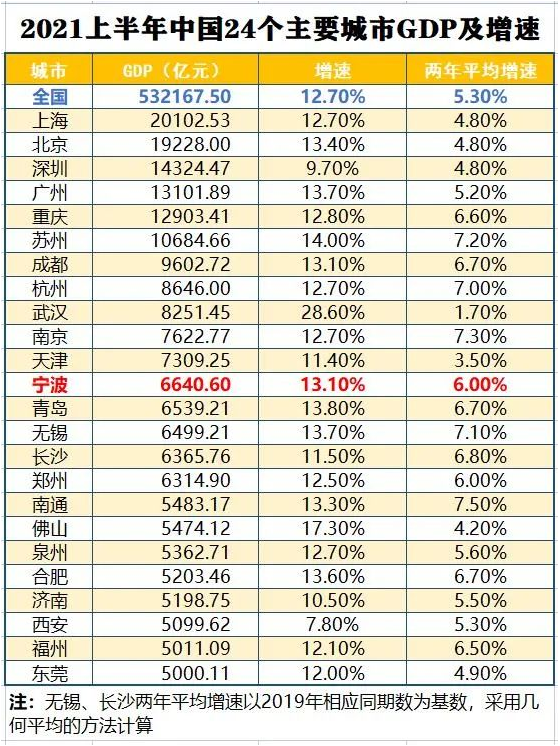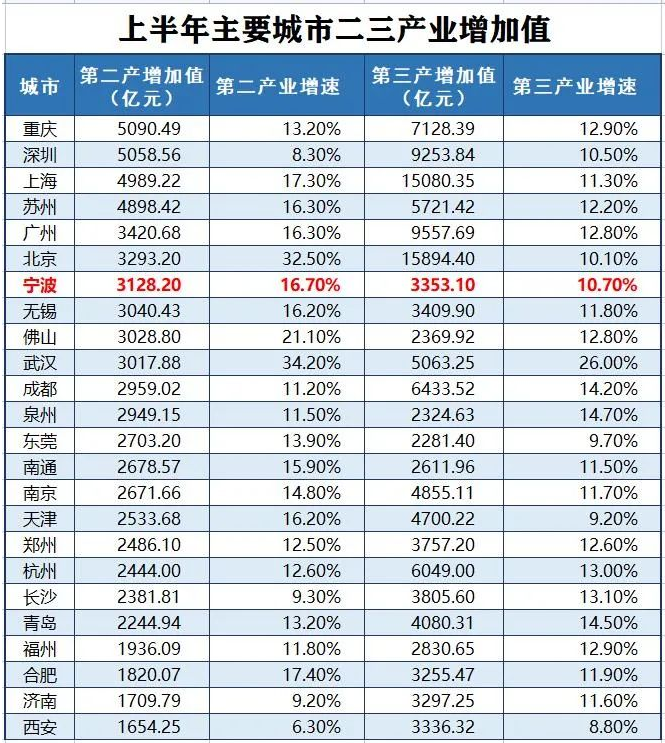Ningbo's economy in the first half of 2021
- Details
- Category: Ningbo News
- Published: Tuesday, 31 August 2021 13:58
As the "locomotive" of national economic development, the report card of 23 cities with a GDP exceeding one trillion yuan in the first half of 2021 is quite noticeable.
In the "Trillion Club", Ningbo ranks 12th with a regional GDP of RMB664.06 billion. The GDP growth rate of 13.1% is tied for 10th with Chengdu.
In the first half of the year, Ningbo performed well in terms of GDP growth, total industrial output value, total foreign trade import and export, and industrial investment.
Among the 23 cities with a GDP exceeding one trillion yuan, Ningbo's GDP in the first half of the year happened to be in the middle. Fortunately, in the first half of the year, the added value of Ningbo's secondary industry reached RMB312.82 billion, ranking 7th; the growth rate reached 16.70%, ranking 6th

Among the five cities (Ningbo, Qingdao, Wuxi, Changsha, Zhengzhou) with a GDP of RMB600 billion to 700 billion in half a year, Ningbo's secondary industry has a clear lead, especially compared with cities such as Qingdao, Changsha, and Zhengzhou. This fully reflects the characteristics of Ningbo's manufacturing market

It is particularly worth mentioning that in the first half of the year, Ningbo achieved a total industrial output value of RMB1,040.62 billion, a year-on-year increase of 29.6%. This is the first time that Ningbo's total industrial output value in the first half of the year “breaks one trillion yuan”.
In the first half of the year, Ningbo achieved a sales output value of RMB1,020.68 billion, a year-on-year increase of 31.0%. The production and sales rate is as high as 98.1%. It can be seen that Ningbo's industrial production is booming in both production and sales. At the same time, Ningbo PMI has continued to expand for 13 consecutive months, and the confidence of market players has continued to increase.
According to the survey on the business prospect of industrial enterprises in Ningbo, in the second quarter, 89.2% of industrial enterprises in Ningbo received higher or normal product orders; 85.7% of industrial export enterprises received higher or normal export orders.
The data shows that the leading role of Ningbo's manufacturing investment is obvious. In the first half of the year, Ningbo's fixed asset investment increased by 16.4% year-on-year, and the two-year average growth rate was 9.8%, 2.6 percentage points higher than the first quarter. Among them, private investment increased by 14.4%, an average increase of 9.1% in two years.
From the perspective of investment composition, manufacturing investment increased by 39.8%, contributing 43.2% to investment growth; real estate development investment increased by 20.5%, and the two-year average growth rate was 21.7% and 12.2% respectively.
In the first half of the year, many large and good projects in Ningbo were completed and put into production one after another.
In Cixi, Bull Group Co., Ltd. completed the construction of a production base with an annual output of 410 million sets of wall switches and sockets at the end of March; in Fenghua, the project of a smart factory with an annual output of 800 million bottles of lactic acid bacteria implemented by Efule Biotechnology Co., Ltd. was completed and put into production in April; in Beilun, Nata Optoelectronic has built an ArF photoresist production line with a capacity of 25 tons......
In the tertiary industry, Ningbo is relatively weak, ranking last among the five cities with the similar GDP. In the first half of the year, the added value of Ningbo's tertiary industry reached RMB335.31 billion, ranking 16th among 23 cities with a GDP over a trillion yuan; the growth rate reached 10.7%, ranking 19th.
However, Ningbo's service industry has achieved rapid growth in some key industries. Among them, the accommodation and catering industry increased by 23.1%, the wholesale and retail industry increased by 18.9% year-on-year, the information transmission, software and information technology service industry increased by 17.1%, and the transportation, storage and postal industry increased by 14.4%.
In the first half of the year, as an export-oriented city, with the help of first-class port conditions and a good business environment, Ningbo's foreign trade remained highly competitive in the pandemic.
In the first half of the year, Ningbo completed a total foreign trade import and export volume of RMB563.89 billion, a year-on-year increase of 30.7%, an average increase of 14.0% in two years, 1.5 percentage points higher than the first quarter.
Among them, exports reached RMB358.16 billion, an increase of 28.4%, an average increase of 13.5% in two years; imports amounted to 205.73 billion yuan, an increase of 35.0%, and an average increase of 14.9% in two years. The share of foreign trade exports in the country was 3.64%, an increase of 0.02% over the same period last year.
If this growth rate maintains in the second half of the year, Ningbo's foreign trade is quite likely to break a trillion yuan mark.
Of course, while Ningbo is striving to be the first, others are also catching up. Judging from the GDP data in the first half of the year, Qingdao and Wuxi, ranking 13th and 14th respectively, are very close to Ningbo-the GDP of the two cities in the first half of the year reached RMB653.921 billion and RMB649.921 billion, only about a 10- billion gap with Ningbo. Moreover, Qingdao and Wuxi are both higher than Ningbo both in the half-year growth rate and the two-year average growth rate.
2
Affected by factors such as repeated epidemics and floods, the economic development of some regions has encountered greater uncertainty, which has brought considerable changes to the year-end rankings of 23 cities with a GDP over a trillion.
So, how can Ningbo continue to make efforts in the second half of the year?
In the first half of the year, the added value of Ningbo's "246" industrial clusters increased by 20.5% year-on-year, which exceeded the growth rate of industries above the designated size by 0.4 percentage points, stimulating the growth rate of industries above the designated size by 16.1 percentage points. Among them, new materials, key basic parts, high-end equipment, electronic information and other clusters increased by more than 30%.
In the second half of the year, Ningbo will further focus on key areas, continuously increase the gold content of industrial growth, deepen the creation of iconic industrial chains, cultivate and strengthen market players, encourage enterprises to strengthen innovation, and focus on expanding investment in the manufacturing industry, digital empowerment, quality and efficiency improvement, etc.
In the face of repeated epidemics, high freight rates, fluctuations in raw material prices, and difficulties in financing credit, all parties are generally cautiously optimistic about the foreign trade situation in the second half of the year.
In the first half of the year, Ningbo's investment in fixed assets increased significantly. Among them, industrial investment increased by 35.0% year-on-year, 22 percentage points higher than the annual target and 9.1 percentage points higher than the province. However, investment in infrastructure and transportation is relatively weak.
In the second half of the year, Ningbo will further expand investment, focus on optimizing the investment structure, strengthen the inventory management of major projects, and promote the growth of industrial investment, infrastructure investment, and ecological and environmental protection investment, which will contribute to economic growth, industrial transformation, green and low-carbon development, and urban and rural quality improvement
